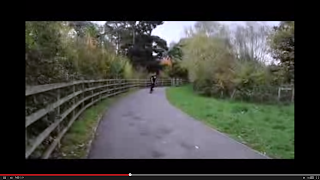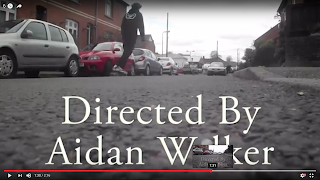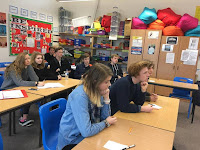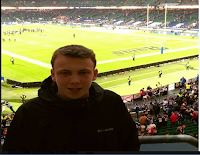There is also photogenic evidence of how progressed I am since the prelim, on the prelim bare in mind Ruben did do the Cinematography and it will be hard to compete as he is a fantastic filmer, however at the time he had as much knowledge as myself, so to prove how different the shots are shows how well I've progressed, there is also the editing. The prelim had little to none (titles - transitions), however that has changed. My product has well placed titles al edited intensely, not too mention the dissolves which work really well. Here are some comparisons to show you how far I have come since the prelim.
*(Prelim task photos are above final)*
Here we can see a huge difference in the first opening shots of each task.
Our prelim nearly follows the rule of 3rds, however due to no establishment we are unsure where the text is set. It's a well framed shot, however there are no titles which are essential and it doesn't really follow the film convention of setting the scene.
Shot rating 5-6/10
Taken from final - For me a much more confident shot, you can see how my progression of camera work has gone. The shot works really well with the titles, and it sets the scene rather well. Unfortunetly the camera quality isn't amazing, but this is something ill improve upon next year. Which brings me to the point that watching this clip, it looks far more professional, there is less unconventional sound and follows non-diegetic and ambient sound in which the prelim shot does
not.
Shot rating 10/10
Here with have two door scenes the prelim is an over the shoulder shot (basic camera knowledge we established for the prelim). however when editing, we didn't pay attention to the fact that if you watch the clip slowly our actor behind the door (Jack) is in fact laughing which can impact miss-en-scene as he is out of character. The shot also lacks composition and doesn't follow rule of thirds.
Shot rating 4/10
For me this final task shot is clean, its a long shot continued from match on action for effect. The long shot establishes the scene and allows us to see what kind of place our protagonist lives in. It is also a perfect shot for titles which appear after this screenshot which flow very well! For me the lighting is also better, as it is more natural and reflects the mood of the character. Certainly a huge step up and sign of progression from our prelim.
Shot rating 8/10
Another error in this prelim shot, despite rule of thirds, it was down w/o a tripod proving to be shaky and lose us marks which we learnt from, by using a tripod for a lll but one scene in our final. In this shot if you watch the mirror closely, you will notice the cameraman is fully visible which doesn't happen in any films.
Shot rating 3/10
This for me is a clean pan, we pan from the window to our sleeping character - after establishing the home place of our character.
Not too much going on but the pan, which made it perfect for us to add in more titles to fill the scene and direct focus on anything but our character (in bed). The use of a tripod made the shot cleaner and by editing out the Audio we made it possible to remove any unnecessary noise. Shot rating 8/10

Here we have to similar shots, both follow rule of thirds to allow audience to adapt to the surroundings. However basic error in the prelim,
NO TRIPOD! Therefore the image was shaky. The lighting is also far worse, if you compare the two, the final is brighter and looks cleaner/sharper because the lighting gives added effect. It's also a basic student shot thats very plain.
Shot rating 3/10
The final shot, is a clean product, rule of thirds applies, there is a slight pan as our character rides off of shot, but it doesn't entirely focus on our character, it adapts the audience to the surroundings to give them their stereotype of a kid skating in a rural area.
The added dialogue stops this scene from also being plain and works well with the music.
Shot rating 8/10
The following shots are comparisons between the original rough cut, and the nearly finalised product. (Finalised-newer product images are above)
There is no titles in this shot. I applied the rule of thirds to create more of an effect, and used cross dissolves to speed up the shot and create a time effect. I think the shot is very clean and speaking to a primary audience member (India - refer to lasted audience post) she especially went on about this shot and that how it looks far better w/o titles.
Shot Rating 9/10
For me this second edit, really isn't as smooth, the added gravel audio isn't really done well, it is essentially louder than the music which ruins the effect. Obviously its a diegetic sound so it should be quieter on the audio to emphasis this. The titles also look poor and are placed far too late. As the distributor is a key role and should be in the first few titles. Rule of thirds applies and so does the dissolve edit that I DID, to create effect.
Shot Rating 6-7/10
Here is a comparison of the first establishing shots in both texts. As you can see, in the later edition the newer edit looks much more cleaner and establishes the scene very well, the colours contrast well, and their is use of both rule of thirds and composition. For the viewing audience (I asked 8 people) 6 said they preferred this edition.
Shot rating 9/10
The less preferred shot by audience and myself, clear to see why, there is a lot of messiness with the lens flare which will only bring down my camera marks, the bridge dominates the shot and doesn't really allow us to establish much of the scene. Has potential but doesn't follow and rule of thirds scheme.
Shot rating 7/10
Examples of titles now, i am aware that in the top frame the titles have changed due to ordering and i plan to follow drama conventions. (Posted before final product uploaded) However both shots have the same to be said, very clean really establish the scene. Long shots in which the focus is on the lower half of our character to emphasise on his skater background.

However, comparing the tiles of the shots, the rough cut really doesn't look very good, there is no edit on their appearance, and they look plain and basic. Therefore looking very student-like, ruining the movie effect of a film.
Whereas in the newer edit, the titles look so clean, they can be re adjusted which is currently in process for the final edition. However the font really flows, they're subtle and don't look bland
Shot rating 10/10 (newer)
Shot rating 6/10 (rough)
Again, two establishing shots. The newer edit looks far cleaner and shorter, their is ambient sound which increases the effect of adapting audience to the environment. It looks smart in that it sets the scene for our audience, a tripod was used (as it was in the others) and helps the stability.
Shot rating 9/10
Just doesn't look as good, the church bell ambience isn't present reducing effect. The titles pop up far too early for a cinematographer. And ruins the shot smoothness as on the left you can make out a purple lens flare, which means the shot isn't following basic miss-en-scene. Also the titles are so out of proportion, they're slap bang in your face, and stop the audience from adapting to the scene/area establishment.
Shot rating 6/10
The purpose of these shot analysis' is to prove my advancement of how far i have progressed since the prelim, the second lot may not be my prelim, but they still show proof of my advancement and progression since the prelim. Simply as i have now progressed in that i can myself evaluate shots and how small things can have big impacts, not only but how i can use the primary audiences opinions to choose my shots so they work in favour of the audience. unlike the prelim and rough cuts.

These two storyboards (reference to animatic post as well), prove how far we have come since the prelim. When making th prelim we just turned up and made a film out of anything. However with weeks of planning i put my arty skills to good use and decided to make a storyboard so we had something to refer to, and help us guide us through shooting to nail shots. Furthermore allowing our shots to be more effective in the final - also with use of a tripod for stability.

The use of tripods and different angles (crab-establishing shots, and the use of multiple takes) have also helped us, as if one shot had something wrong or out of place (mise-en-scene) we had plenty more shots to refer to. Not only but we could reference the various shots of individual places to our audience. Getting their feedback to improve our film drastically. Looking at the rough cut and final edition, you can really see that we have used different shots, and how much sharper the newer one looks. It has also taught us to use great preparation, as in the prelim we had one shot for every take so they had to be good else our product wasn't good. Which is bad planning as had we taken more takes their would have been a choice and possibly better shots to choose from.




















































